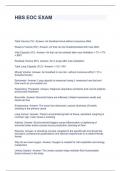Reserve volume rv - Study guides, Class notes & Summaries
Looking for the best study guides, study notes and summaries about Reserve volume rv? On this page you'll find 222 study documents about Reserve volume rv.
Page 3 out of 222 results
Sort by
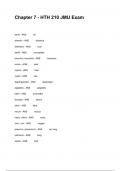
-
Chapter 7 - HTH 210 JMU Exam Questions With Complete Answers
- Exam (elaborations) • 14 pages • 2024
-
Available in package deal
-
- $10.89
- + learn more
aer/o - ANS air alveol/o - ANS alveolus anthrac/o - ANS coal atel/o - ANS incomplete bronch/o, bronchi/o - ANS bronchus coni/o - ANS dust cyan/o - ANS blue cyst/o - ANS sac diaphragmat/o - ANS diaphragm epiglott/o - ANS epiglottis hal/o - ANS to breathe laryng/o - ANS larynx lob/o - ANS lobe muc/o - ANS mucus nas/o, ...
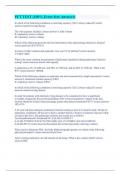
-
PFT TEST (100% Error-free Answers)
- Exam (elaborations) • 10 pages • 2023
-
Available in package deal
-
- $10.59
- + learn more
In which of the following conditions is total lung capacity (TLC) always reduced? correct answers restrictive lung disease The vital capacity includes: correct answers I. tidal volume II. inspiratory reserve volume III. expiratory reserve volume Which of the following provides the best information when determining obstructive disease? correct answers FEV1/FVC% In terms of other volumes and capacities, how can VC be defined? correct answers VT+IRV+ERV What is the most common measure...
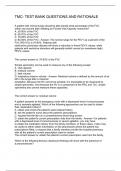
-
TMC- Test bank questions and rationale
- Exam (elaborations) • 12 pages • 2023
-
- $12.49
- + learn more
A patient with normal lungs should be able exhale what percentage of the FVC within one second after initiating an Forced Vital Capacity maneuver? A. 35-50% of the FVC B. 50-70% of the FVC C. 70-83% of the FVC D. 84-93% of the FVC - Answer- The normal range for the FEV1 as a percent of the FVC (FEV1%) is 70-83%. Patients with obstructive pulmonary disease will show a reduction in timed FEV% values, while patients with restrictive disorders will generally exhibit normal (or sometimes high)...
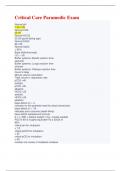
-
Critical Care Paramedic Exam 2023
- Exam (elaborations) • 31 pages • 2023
- Available in package deal
-
- $12.49
- + learn more
Normal pH - Answer- 7.35-7.45 Normal CO2 - Answer- 35-45 Normal HCO3 - Answer- 22-26 (good dating age) Normal PaO2 - Answer- 80-100 Normal SaO2 - Answer- > 95% Base (deficit/excess) - Answer- (-2) - (+2) Buffer systems: Bicarb reaction time - Answer- seconds Buffer systems: Lungs reaction time - Answer- minutes Buffer systems: Kidneys reaction time - Answer- hours to days Minute volume calculation - Answer- Tidal volume x respiratory rate pCO2 >45 - Answer- acidotic pCO2 <35 - Answer- a...
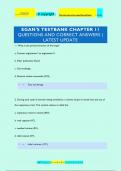
-
EGAN'S TESTBANK CHAPTER 11 QUESTIONS AND CORRECT ANSWERS | LATEST UPDATE
- Exam (elaborations) • 53 pages • 2024
- Available in package deal
-
- $13.49
- + learn more
What is the primary function of the lungs? a. Convert angiotensin I to angiotensin II. b. Filter pulmonary blood. c. Gas exchange. d. Remove carbon monoxide (CO). -:- Gas exchange. 2. During each cycle of normal resting ventilation, a volume of gas is moved into and out of the respiratory tract. This cyclical volume is called the: a. inspiratory reserve volume (IRV). b. vital capacity (VC). c. residual volume (RV). d. tidal volume (VT). -:- tidal volume (VT). 2 | P a g e | G r...
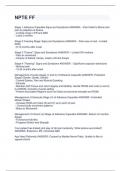
-
NPTE FF|QUESTIONS WITH 100% CORRECT ANSWERS|VERIFIED
- Exam (elaborations) • 61 pages • 2024
-
- $20.49
- + learn more
NPTE FF Stage 1 Adhesive Capsulitis Signs and Symptoms ANSWER- - Pain Distal to Elbow and pain to palpation at Sulcus - Limited range in ER and ABD - Lasts 3 months Stage 2 Freezing Stage: Signs and Symptoms ANSWER- - Pain even at rest - Limited ROM - 9-15 months after onset Stage 3 "Frozen": Signs and Symptoms ANSWER- - Limited GH motions - Pain w/ movement - Atrophy of deltoid, biceps, rotator cuff and triceps Stage 4 "Thawing": Signs and Symptoms ANSWER- - Significant c...
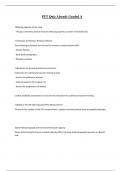
-
PFT Quiz Already Graded A
- Exam (elaborations) • 6 pages • 2024
-
Available in package deal
-
- $10.29
- + learn more
PFT Quiz Already Graded A Diffusing Capacity of the Lung - The gas commonly used to measure diffusing capacity is carbon monoxide (CO). Techniques to Measure Residual Volume The following techniques can be used to measure residual volume (RV): - Helium dilution - Body plethysmography - Nitrogen washout Indications for Assessing Pulmonary Function Indications for pulmonary function testing include: - Screen for pulmonary disease - Evaluate patients for surgical risk - Assess the progres...

-
Flight Paramedic Ventilator Patient Management Exam Questions and Answers 100% Verified
- Exam (elaborations) • 4 pages • 2024
-
- $10.49
- + learn more
Flight Paramedic Ventilator Patient Management Exam Questions and Answers 100% Verified What is the abbreviation for tidal volume? - answerVt What is the abbreviation for inspiratory reserve volume? - answerIRV What is the abbreviation for expiratory reserve volume? - answerERV What is the abbreviations for vital capacity? - answerVC What is the abbreviation for residual volume? - answerRV What is the abbreviation for total lung capacity? - answerTLC What is tidal volume? - answeramount...
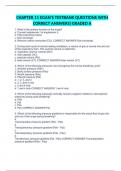
-
CHAPTER 11 EGAN'S TESTBANK QUESTIONS WITH CORRECT ANSWERS|GRADED A|100% verified|19 pages
- Exam (elaborations) • 19 pages • 2024
-
- $12.99
- + learn more
CHAPTER 11 EGAN'S TESTBANK QUESTIONS WITH CORRECT ANSWERS|GRADED A 1. What is the primary function of the lungs? a. Convert angiotensin I to angiotensin II. b. Filter pulmonary blood. c. Gas exchange. d. Remove carbon monoxide (CO). CORRECT ANSWER Gas exchange. 2. During each cycle of normal resting ventilation, a volume of gas is moved into and out of the respiratory tract. This cyclical volume is called the: a. inspiratory reserve volume (IRV). b. vital capacity (VC). c. residual v...

Study stress? For sellers on Stuvia, these are actually golden times. KA-CHING! Earn from your study resources too and start uploading now. Discover all about earning on Stuvia



